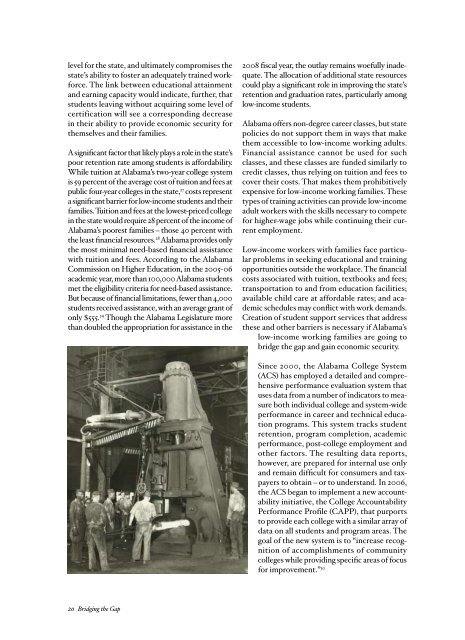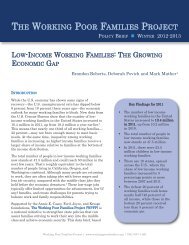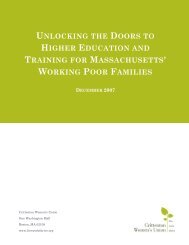alabama's working families and the broken promise of economic ...
alabama's working families and the broken promise of economic ...
alabama's working families and the broken promise of economic ...
- No tags were found...
You also want an ePaper? Increase the reach of your titles
YUMPU automatically turns print PDFs into web optimized ePapers that Google loves.
level for <strong>the</strong> state, <strong>and</strong> ultimately com<strong>promise</strong>s <strong>the</strong>state’s ability to foster an adequately trained workforce.The link between educational attainment<strong>and</strong> earning capacity would indicate, fur<strong>the</strong>r, thatstudents leaving without acquiring some level <strong>of</strong>certification will see a corresponding decreasein <strong>the</strong>ir ability to provide <strong>economic</strong> security for<strong>the</strong>mselves <strong>and</strong> <strong>the</strong>ir <strong>families</strong>.A significant factor that likely plays a role in <strong>the</strong> state’spoor retention rate among students is affordability.While tuition at Alabama’s two-year college systemis 59 percent <strong>of</strong> <strong>the</strong> average cost <strong>of</strong> tuition <strong>and</strong> fees atpublic four-year colleges in <strong>the</strong> state, 27 costs representa significant barrier for low-income students <strong>and</strong> <strong>the</strong>ir<strong>families</strong>. Tuition <strong>and</strong> fees at <strong>the</strong> lowest-priced collegein <strong>the</strong> state would require 28 percent <strong>of</strong> <strong>the</strong> income <strong>of</strong>Alabama’s poorest <strong>families</strong> – those 40 percent with<strong>the</strong> least financial resources. 28 Alabama provides only<strong>the</strong> most minimal need-based financial assistancewith tuition <strong>and</strong> fees. According to <strong>the</strong> AlabamaCommission on Higher Education, in <strong>the</strong> 2005-06academic year, more than 100,000 Alabama studentsmet <strong>the</strong> eligibility criteria for need-based assistance.But because <strong>of</strong> financial limitations, fewer than 4,000students received assistance, with an average grant <strong>of</strong>only $555. 29 Though <strong>the</strong> Alabama Legislature morethan doubled <strong>the</strong> appropriation for assistance in <strong>the</strong>2008 fiscal year, <strong>the</strong> outlay remains woefully inadequate.The allocation <strong>of</strong> additional state resourcescould play a significant role in improving <strong>the</strong> state’sretention <strong>and</strong> graduation rates, particularly amonglow-income students.Alabama <strong>of</strong>fers non-degree career classes, but statepolicies do not support <strong>the</strong>m in ways that make<strong>the</strong>m accessible to low-income <strong>working</strong> adults.Financial assistance cannot be used for suchclasses, <strong>and</strong> <strong>the</strong>se classes are funded similarly tocredit classes, thus relying on tuition <strong>and</strong> fees tocover <strong>the</strong>ir costs. That makes <strong>the</strong>m prohibitivelyexpensive for low-income <strong>working</strong> <strong>families</strong>. Thesetypes <strong>of</strong> training activities can provide low-incomeadult workers with <strong>the</strong> skills necessary to competefor higher-wage jobs while continuing <strong>the</strong>ir currentemployment.Low-income workers with <strong>families</strong> face particularproblems in seeking educational <strong>and</strong> trainingopportunities outside <strong>the</strong> workplace. The financialcosts associated with tuition, textbooks <strong>and</strong> fees;transportation to <strong>and</strong> from education facilities;available child care at affordable rates; <strong>and</strong> academicschedules may conflict with work dem<strong>and</strong>s.Creation <strong>of</strong> student support services that address<strong>the</strong>se <strong>and</strong> o<strong>the</strong>r barriers is necessary if Alabama’slow-income <strong>working</strong> <strong>families</strong> are going tobridge <strong>the</strong> gap <strong>and</strong> gain <strong>economic</strong> security.Since 2000, <strong>the</strong> Alabama College System(ACS) has employed a detailed <strong>and</strong> comprehensiveperformance evaluation system thatuses data from a number <strong>of</strong> indicators to measureboth individual college <strong>and</strong> system-wideperformance in career <strong>and</strong> technical educationprograms. This system tracks studentretention, program completion, academicperformance, post-college employment <strong>and</strong>o<strong>the</strong>r factors. The resulting data reports,however, are prepared for internal use only<strong>and</strong> remain difficult for consumers <strong>and</strong> taxpayersto obtain – or to underst<strong>and</strong>. In 2006,<strong>the</strong> ACS began to implement a new accountabilityinitiative, <strong>the</strong> College AccountabilityPerformance Pr<strong>of</strong>ile (CAPP), that purportsto provide each college with a similar array <strong>of</strong>data on all students <strong>and</strong> program areas. Thegoal <strong>of</strong> <strong>the</strong> new system is to “increase recognition<strong>of</strong> accomplishments <strong>of</strong> communitycolleges while providing specific areas <strong>of</strong> focusfor improvement.” 3020 Bridging <strong>the</strong> Gap







